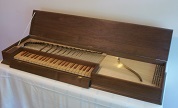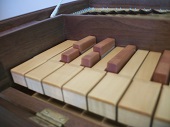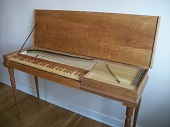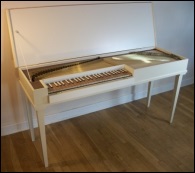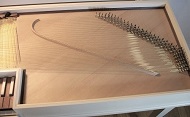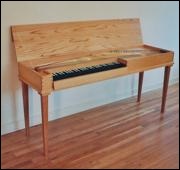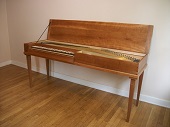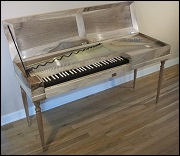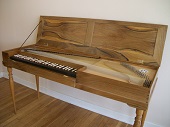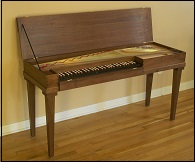  
 
   
 
 
 
 
  
P.O. Box 1163
Lemont, PA 16851
(814) 883-7799
damaple@comcast.net |  | 


I have made a number of different clavichord models over four decades. These listed here are among my
favorites. I am also happy to discuss earlier instruments,
both triple- and double-fretted, as well as other models of large, unfretted
instruments.
Please click on the images below for enlarged versions.

17th-century fretted clavichord
This double-fretted clavichord is based on an anonymous instrument in the Musical Instrument Museum in Leipzig. The compass is C/E-c3, which was standard for most of the 17th century. The antique has the common C/E short octave configuration in the bass, with no split sharps. Due to the generous spacing of the strings on the bridge, however, is was a simple matter to add one course of strings
and to rearrange the key levers so that split sharps could be added to supply the low F# and G# that are needed for playing the literature from the end of the century.
The soundboard and bridge are longer than usual for 17th-century instruments, and the bridge is also taller and somewhat heavier. As a result, the instrument has a more sonorous and sustaining sound, compared to many contemporary clavichords that have a more rapid decay. The string scaling is short and appropriate for brass stringing tuned to the common tone-high pitch known as Chorton in the late Baroque.
Specification:
C/E-c3, short octave, A-466. Case of varnished hardwood, or
pine with a painted finish (as in the original). 114 x 33 cm
(45 x 13 in).

18th-century fretted clavichord
The compass of this anonymous double-fretted instrument from the Metropolitan Museum of Art in New York extends to e3, which probably dates it
from the second quarter of the 18th century. It is still relatively small and
easily portable, however. The instrument's sound also is similar to small, earlier instruments, with a sweet treble and a gentle, lute-like bass.
The treble compass can be extended to f3if desired. With its chromatic bass to C, the instrument is capable of playing a wide range of pieces, subject to the restrictions of the fretting system.
18th-century fretted clavichord demonstration video 🔊
Specification:
C-e3, chromatic, A-415. Case of varnished hardwood, or
pine with a painted finish (as in the original). 114 x 36 cm
(45 x 14 in).

Unfretted clavichord after Specken
Philip Jacob Specken apprenticed with the great organ and stringed-keyboard maker Gottfried Silbermann in Freiberg, Saxony, and then
relocated to Stockholm in the 1730s. He was initially employed there by several other masters, but by 1737 he was signing instruments with
his own name. In the 1740s he produced a series of clavichords that were very similar to the
Saxon design used by Friederici and other later Silbermann apprentices. Both fretted and unfretted instruments were made in his shop,
mostly with the range of C-d3;
by around 1748 Specken sometimes extended the upper compass to include e3.
Due to the relatively long length of the bridge in the bass, no over-wound strings are required. The sound of the bass is full, but noticeably distinct in timbre from the sound produced by over-wound strings. The overall sound is resonant and singing, with good sustain. With its mid-century compass and its lineage to Silbermann's clavichords, Specken's model is especially appropriate for the music of J. S. Bach, his sons, and their contemporaries.
Specification:
C-e3, chromatic, A-410. Case of varnished hardwood or painted pine. Ebony or plum naturals
and bone-capped accidentals. Four screw-on legs are included in the base
price. 151 x 46 cm (59 x 18 in).

Unfretted clavichord after Friederici
Another apprentice of Silbermann, who became one of the leading Saxon makers in the second half of the 18th century, was Christian Ernst Friederici. He shared a workshop with his younger brother, Christian Gottfried, in Gera near Dresden, where they built clavichords that transformed the original Silbermann design into larger, more powerful instruments that reflected trends in the music of their time.
Although these Friederici instruments look a lot like the Specken model, there are in fact a number of important differences. The case and soundboard have been widened and lengthened to accomodate a full five-octave compass, with a greater case depth. The key levers and bridge are longer and significantly more massive, creating differences in the feel and response of the action and in the quality of the sound produced. While still capable of being played very subtly and expressively, these later instruments have a substantial presence to them, and a good example will fill a domestic room with sound. These revisions to the design also tend to present a harder "playing surface" that can be challenging to control, especially for less experienced players. For advanced players with secure technique, however, the instruments offer many coloristic and expressive possibilities.
Two notable owners of Friederici clavichords were C. P. E. Bach and Leopold Mozart. Bach clearly stated in his writings that he preferred Saxon instruments because of the way they felt under the hands, and for their use of over-wound strings in the bass, rather than relying on a 4' choir to brighten the sound of unwound bass strings. The wound string technology of the second half of the century was indeed a key factor in the development of the late Saxon clavichord sound, and using wound strings on notes with relatively long string lengths gave these instruments a new type of powerful bass that Bach and his contemporaries exploited in their music.
I have modeled my large Saxon clavichord after a well-known example from the Musical Instrument Museum in Leipzig, signed by the younger Friederici brother, Christian Gottfried, and dated 1765.
Specification:
FF-f 3, chromatic, A-415. Case of varnished hardwood. Ebony naturals
and bone-capped accidentals. Four screw-on square-tapered legs are included in the base
price. Other case woods, a soundboard rose, interior veneering, and alternate leg styles are
available as options. 175 x 50 cm (69 x 20 in).

Unfretted clavichord, adapted from J. H. Silbermann
Like Specken and C. E. Friederici, Johann Heinrich Silbermann also learned his trade as an instrument maker by working for a time in the workshop of his uncle Gottfried. He later returned to his native Strasbourg to open his own shop, which produced clavichords, harpsichords, and fortepianos.
Although there is one surviving clavichord attributed to Johann Heinrich that is similar to the late Saxon instruments by Friederici and Horn, he is mostly associated with a group of clavichords that share a remarkably compact design. These instruments, which are thought to date
from ca. 1775, are distinguished from late Saxon
instruments by a case that is some 38 cm (15 inches) shorter, the absence of a toolbox to the left of the keyboard, and a bridge that is abrubtly
curved in the bass. Despite these differences, however, study reveals that there are still elements of the core Saxon scaling and layout present.
These compact-design instruments have a bright, clear treble and mid-range with a lively presence and good sustain. Being so short, the bass strings have less power and a different timbre, compared to contemporary Saxon instruments. But the common use of over-wound strings in the second half of the century makes it possible for such short strings to work remarkably well, producing a lighter and more transparent style of bass.
Some features that may affect the sound — such as keeping the left edge of the soundboard perpendicular to the case front, and the shorter, S-shaped bridge located centrally on a smaller, basically square soundboard — can perhaps be seen as looking backward to earlier instruments from the first half of the century. It therefore seems likely that Johann Heinrich's intent was to build clavichords that would have the necessary five-octave compass of the period, but which at the same time would retain some of the flexibility and clarity of the earlier instruments.
While I am happy to reproduce this original compact Silbermann design, I have recently begun to build a slightly revised adaptation that enlarges the case by 10 cm (4 inches), in order to include a tool box — accompanied by cranked lower key levers — and to lengthen the bass end of the bridge somewhat with a more elegant curve. However, the treble and mid-range portions of the soundboard and keyboard faithfully follow the layout of the compact-model instruments. In my opinion, these modest changes improve the sound and touch of the very lowest notes below C without affecting the overall sound quality and resonance of the design.
Silbermann adaptation demonstration video 🔊
Specification:
FF-f 3, chromatic, A-415 (A-440 version is also possible). Case of walnut. Ebony naturals
and bone-capped accidentals. Four screw-on, square-tapered legs are included in the base
price. Other case woods, a soundboard rose, and alternate leg styles are
available as options. 148 x 49 cm (58 x 19 in).

|


